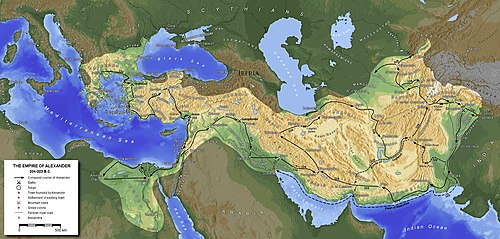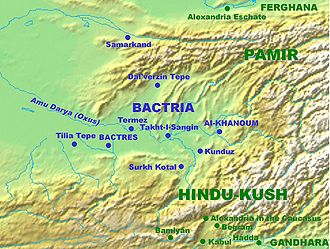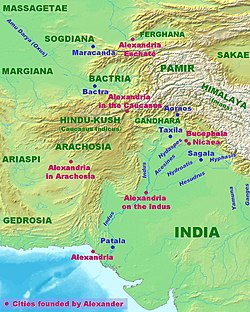Alexander III of Macedon, more commonly known as Alexander the Great, was king of the Ancient Greek kingdom of Macedon, which today is divided among three countries. He inherited the kingdom at the age of 20 in 336 BC, and by the age of 30 he had forged one of the largest empires in the ancient world, uniting the Greek-city states and neighboring foes, taking Egypt, conquering the Achaemenid (First Persian) Empire and successfully invading the Indian subcontinent. He died at 32 so he did not rule his empire for long, but after his death dynasties descended from his generals ruled parts of it for centuries.
Never defeated in battle, Alexander is considered to be one of the most successful and influential military leaders of all time. Even today in most armies, officer trainees study his tactics.
Understand
[edit]
Alexander's conquests covered a wide area. A first approximation to following his route today would be the Hippie Trail of the 1970s, overland from Istanbul to Delhi. However that route generally omits Greece and various areas he conquered — the Levant, Egypt, Iraq and the northern parts of the Persian Empire in Central Asia. It also extends to Delhi, beyond the part of the subcontinent that he conquered.
Trade along the Silk Road became well established not long after Alexander, and much of that route was in territory he had conquered.
Alexander founded or renamed many cities; Wikipedia has a list of the more important ones, and we mention some below. Most were in strategic locations, and many of the initial inhabitants were veterans.
Destinations
[edit]We list some of the main sites along Alexander's route below, in the order he visited them so mainly west to east. Sites which are important only as battlegrounds have red markers. Other places get green markers, though there were also battles for many of those.
Greece
[edit]Philip II of Macedon was Alexander's father. His alliances and conquests, and Alexander's early ones, gave the Macedonians control of all of Greece and some nearby areas:
- 1 Pella. Alexander's birthplace and Macedonian capital. In 168 BC, it was sacked by the Romans, and its treasury was transported to Rome. Nowadays it's a rich archaeological site with a fine museum.
- 1 Chaeronea, Boeotia. In 338 BC, Philip led the Macedonians against the combined forces from Athens and Thebes. Alexander was in charge of the left wing and was the first to break the ranks of the elite force of the Theban infantry, known as the Sacred Band.
In 336 BC Philip was assassinated by his bodyguard and Alexander was proclaimed king. Philip had forged and led an alliance, the Hellenic League, which united most of Greece to attack the Persians, who had invaded Greece during the previous century and still controlled many areas in Anatolia (now Asiatic Turkey) where the population was predominately Greek. After Philip's death, Alexander was appointed its leader.
- 2 Pelion. In 335 BC, Alexander undertook a siege at Pelion against an Illyrian coalition. The Macedonians defeated the Illyrians, and built a new outpost to secure their northern border. While Pelion is known to be in modern-day Albania, the exact location is not known.
- 2 Thebes. This was the most important city-state of central Greece at the time. While Alexander was dealing with the Illyrians, Thebes and other cities of the Hellenic League revolted. Alexander took Thebes and destroyed the city; after that, the other allies became cooperative again. The modern city of Thebes is not particularly large or interesting but does have an excellent archaeological museum.
Mediterranean
[edit]With the Greek base secured, and many Greek allies, Alexander moved against Mediterranean areas held by Persia:
- 3 Granicus River. Philip had sent a force into Anatolia, and shortly after ascending the throne, Alexander went to join them, bringing reinforcements. The Persians tried unsuccessfully to stop him near the site of ancient Troy.
- 3 Gordion (Central Anatolia). This city was the capital of Phrygia, once an independent kingdom that ruled most of Anatolia, but by Alexander's time Phyrgia had been reduced to a province of the Persian Empire. It had a complex knot, allegedly tied by the city's founder, and a legend that whoever could untie it would rule Asia. Alexander took his sword to it, "cutting the Gordian knot".
Today Gordion is an archaeological site about 80 km (50 miles) south of the Turkish capital Ankara.

- 4 Issus (Syrian Gate). This was the first of Alexander's battles in which the opposing Persian forces were led by their Emperor, Darius III, in person. The Greeks won, despite being seriously outnumbered. The battle took place in 333 BC.
- 4 Iskenderun (Alexandretta). Founded as Alexandria ad Issum, to control the "Syrian Gate" pass over which the Battle of Issus was fought. Today Iskenderun is the biggest city in Turkey's Hatay province, on the shore of the Mediterranean, with a pleasant palm-lined waterfront.
- 5 Tyre (South Lebanon). This Phoenician city, already ancient in Alexander's day, was the site of Alexander's most famous siege. Later it was an important city under the Romans. Today it is Lebanon's fourth largest city, known for well-preserved Roman architecture, including the largest and best-preserved example of a Roman Hippodrome, and for fine beaches.
- 6 Gaza. Alexander besieged this city. After three unsuccessful attempts, he breached the walls on the fourth attempt and his infantry overwhelmed the defenders. Once the city fell, most men of fighting age were slaughtered while the women and children were sold into slavery.
Taking Gaza opened up the pathway for the Macedonians and their allies to march into Egypt, and once Gaza fell the Persian satrap of Egypt surrendered without a fight.
- 7 Alexandria (Egypt). The greatest city Alexander founded, an important port from his time to the present. Alexander called it his "window on Greece". The Greeks built an extremely tall lighthouse that was one of the seven wonders of the world. However, the lighthouse no longer stands. The famous Library of Alexandria had a size no library in the Mediterranean world would surpass until well after the invention of printing. Every book brought into the busy port had to be given to the library for copying before it could go on its way.
Today Alexander's tomb is one of the city's tourist attractions.
Persia
[edit]After taking Anatolia and Persia's Mediterranean territories, and rejecting a series of peace offers from Darius, he continued eastward to conquer the rest of the Persian Empire:

- 8 Babylon. After his defeat at Issus, Darius withdrew to this ancient city to regroup. Later Alexander chose Babylon as his capital and died there while planning further conquests. Today it is only ruins, located in modern Iraq.
- 5 Gaugamela (Battle of Arbela). This is where Darius's army marching out from Babylon met Alexander's force coming east. It was the decisive battle of the Persian campaign, fought near Dahuk in what is now Iraqi Kurdistan. Again the Greeks were greatly outnumbered but won anyway. Their troops were mostly better armed and trained, and Alexander was tactically clever.
- 9 Susa. This was the administrative capital of Persia; Alexander took it and used as a base for further campaigns. Today the city is called Shush and is not particularly significant, but the ruins of ancient Susa are a
 UNESCO World Heritage Site.
UNESCO World Heritage Site. - 6 Persian Gate. This is a pass in the Zagros Mountains where an outnumbered Persian force managed to hold Alexander off for a month as he brought his army along the Royal Road from Susa to Persepolis.
- 10 Persepolis (Takht-e Jamshid). This was the ceremonial capital of the Persian Empire at the time. Much of the city was destroyed by fire shortly after Alexander took it; some historians believe this was accidental while others think it was deliberate, perhaps revenge for Cyrus burning Athens 150 years earlier. Today its ruins are a UNESCO World Heritage Site and a major tourist destination. The nearest major city, and the usual jumping-off point for visits to Persepolis, is Shiraz.
Central Asia
[edit]After the fall of Persepolis, the Persian Emperor Darius fled to the northern parts of his empire, in Central Asia. Alexander chased him, conquering that region as well.
- 11 Merv. This was the capital of the satrapy of Margiana, the northwestern extreme of the Persian Empire. Alexander took it and called a city there Alexandria in Margiana. Merv was destroyed in one of the Mongol Empire's bloodiest conquests in the 13th century; it was rebuilt but never recovered its former glory. It was destroyed again by the Emir of Bukhara in the 18th century. Today there are only ruins, near Mary, Turkmenistan.

- 12 Sogdia (Transoxania). This was the northeasternmost satrapy of the Persian Empire, the region north of the river then called the Oxus and now Amu Darya. Its greatest cities were Samarkand, top center on the map, and Bukhara further west. Alexander took both. Today the centers of both are UNESCO World Heritage Sites, mainly for Islamic architecture built long after Alexander's time.
- 7 Battle of Jaxartes. This was Alexander's most northeasterly battle, fought along a river then called Jaxartes and now Syr Darya, which formed the northern border of Sogdia. The battleground was near the modern city of Tashkent. The opponents were the Saka, nomadic horsemen from the steppes to the north.There are unhandled parameters: let;
- 13 Khujand. Founded as Alexandria Eschate (furthest Alexandria) mainly to protect the border along the Jaxartes at the northeast extreme of Alexander's empire (top right on the map).There are unhandled parameters: wikpedia;
All the cities mentioned above later became Silk Road trading centers and remained so into medieval times. All except Merv still exist. The Ferghana Valley, top right on the map, became the main Silk Road route from Kashgar to Samarkand.
- 14 Bactria. Before Alexander this region was also part of the Persian Empire; today most of it is in northern Afghanistan. A Graeco-Bactrian Kingdom ruled Bactria, Sogdia and Margiana for about two centuries after Alexander's death. Their capital is shown as Bactres on the map; today it is called Balkh.
From Central Asia he moved to invade the Indian Subcontinent. Along the way he founded several cities:
- 15 Bagram. Alexander built a city called Alexandria on the Caucasus here to control the passes through the Hindu Kush north of Kabul. The location is still strategically important; both the Russians and the Americans put major bases near here when they invaded Afghanistan.
- 16 Herat. Herat is Afghanistan's third-largest city and westernmost important city. It is near the border and has always had strong ties with Persia or Iran. Alexander founded Alexandria Ariana in the area, but its exact location is not now known.
- 17 Kandahar. The city was founded in 330 BC as Alexandria in Arachosia, the recorded name for this city till the Islamic conquest. The name "Kandahar" probably evolved from "Iskandar", the local dialect version of the name Alexander. It was the country's capital in the 18th century and again under Taliban rule. Today it is Afghanistan's second largest city and considered one of the most dangerous.
South Asia
[edit]The Persian Empire under Darius had included Gandhara, now in Pakistan, as its easternmost satrapy. Alexander invited the chieftains there to submit to him as the Empire's new ruler. Some did, but he invaded to subdue the others.

- 18 Khyber Pass (Pakistan). Like other conquerors before and after him, Alexander brought an army through this pass to get from Afghanistan into the subcontinent. The region's hill tribes have always been distinctly fierce and even Alexander could not get through until he bribed some of the local chiefs to assist him against other tribes.
- 19 Taxila. The ruler of this important Gandharan trading city allied himself with Alexander. Later it would be a center of Buddhist art with strong Greek influences. Today it is an important archaeological site and tourist destination, a
 UNESCO World Heritage Site.
UNESCO World Heritage Site. - 8 Battle of the Hydapses. This battle was fought near Jhelum in what is now the Punjab province of Pakistan. Hydapses was the Greek name for what is now called the Jhelum River. The beaten local ruler surrendered and became a subordinate of Alexander.
- Alexander founded two cities along the Hydapses, Bucephela (named for his favourite horse) and Nicaea.
- 20 Alexandria on the Indus. A town with dockyards at the junction of two rivers, the Indus and the Acesines (now called Chenab).
- He also founded another Alexandria at the mouth of the Indus.
The area Alexander took in the subcontinent included much of what is now known as the Punjab. The name means "five waters" in Persian and the region is named for five rivers visible on this map; four are tributaries of the Indus and the fifth is a tributary of one of those.
Taking Gandhara completed Alexander's conquest of what had been the Persian Empire. After that many of his men were reluctant to march further east and some of the generals supported them, pointing out that they had already done a great deal and were a long way from homes and families. Alexander reluctantly acquiesced and led much of the army back to Persia, taking the regions now called Sindh and Balochistan en route.
After Alexander
[edit]Alexander made Babylon the capital of his new empire and retired there after India, building a navy on the Persian Gulf and plotting new conquests, starting with Arabia. He died in Babylon only a few years later in 323 BC; the cause is disputed with typhoid, malaria and poisoning as the leading candidates. After his death, the empire was divided among his generals and there was fighting over the details.

The most important of the generals was Seleucus I Nicator who was given Babylon in the original division and conquered much more. The map shows the Seleucid Empire (light blue) and other Greek-ruled states at the time of his death. This empire lasted until 63 BC when the Roman General Pompey ended it.
After seceding from the Seleucid Empire, a Graeco-Bactrian kingdom ruled a large chunk of Central Asia until about 125 BC. In the second century BC, envoys from them and from the Chinese court both reached Kashgar and encountered each other there. This seems to have been the first contact between China and Europeans and it led to the establishment of Silk Road trade, with the Ferghana Valley as the main route between Kashgar and Samarkand. Around 180 BC the Bactrian kingdom invaded the Indian subcontinent and a Graeco-Indian kingdom survived there until about 10 CE. Taxila has a lot of mainly Buddhist art with obvious Greek influences.
Another general, Ptolemy, became Pharaoh of Egypt with his capital at Alexandria, and built the famous library and lighthouse there. The last ruler of the dynasty he founded was Cleopatra, who died in 30 BC. After that, Egypt became a Roman province; Romans were appointed to the top jobs, while Ptolemaic Greeks were much of the professional class both in government and outside it. Greek was the language of government and Greek culture was quite influential until the Muslim conquest in 641 CE. The Egyptian language now called Coptic, soon written in a Greek-derived alphabet, is in liturgical use to this day.
Stay safe
[edit]While Alexander's conquest established new trading routes and a relative stability in the region, and while it is to some extent co-extensive with the Hippie Trail, much of the route is now dangerous.
In 1979 Iran was taken over by Shia extremists and Afghanistan was invaded by the Soviet Union; neither country has been entirely safe since then. In this century US-led coalitions have invaded Afghanistan and Iraq, while Syria has had a vicious civil war. Other countries in the region also have some problems.
See our article on War zone safety if you are even considering travel to Afghanistan, Iraq or Syria.

